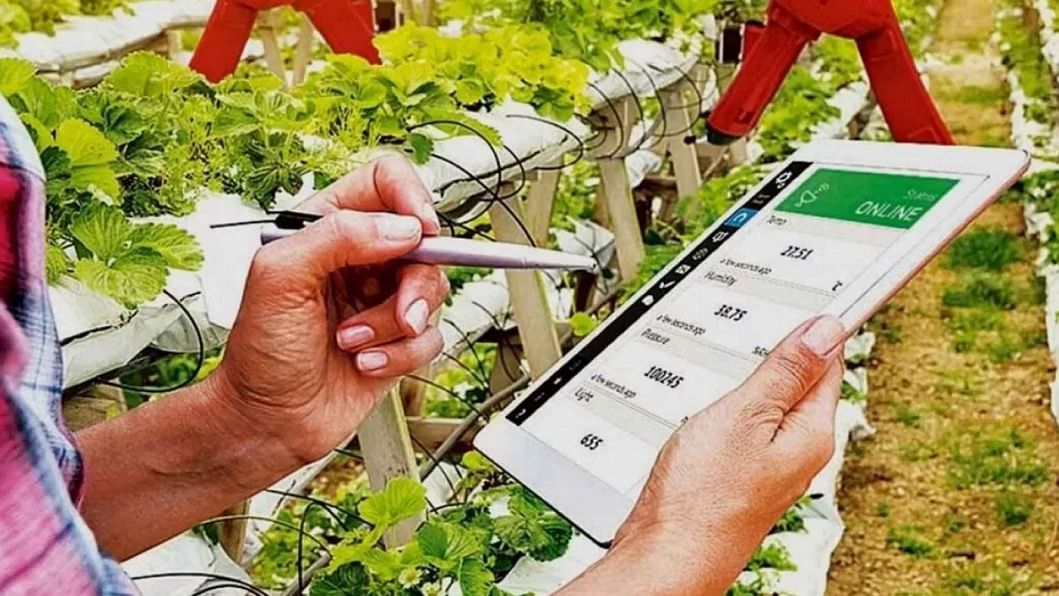How agritech solutions can drive smart development

Bangladesh has set a vision of sustainable, safe and profitable agriculture that is in line with smart development policy. However, agriculture has been struggling with on-farm productivity constraints with respect to 16.5 million small and scattered farm holdings. The average farm size is 0.60 hectares (ha), far below the world's smallholders' holdings of two hectares or less. This small farm size with high fragmentation and low productivity poses a big challenge for food and nutrition security. Arable land is also decreasing due to competing demands for infrastructure and housing settlements. In this context, the agritech vision of "productivity, sustainability and profitability" could be suggested as sustainable intensification solutions for Bangladesh.
Over the last five decades, Bangladesh has achieved productivity gains in rice production, while the productivity is low for non-rice cereal-pulses-oilseeds compared to the regional and global peers. Although Bangladesh is well-known for partial conventional mechanisation (i.e. mechanised land preparation, primary tillage, irrigation, harvesting and threshing, but other operations with human labour), gaps do exist in mechanised planting, application of pesticides, herbicides and fertilisers, and full-scale harvesting operations. Moreover, the increasing scarcity of agricultural labour and rising real wage rate have fuelled productivity constraints. Most younger people are not interested in agriculture as a career.
Furthermore, the typical farming practices in Bangladesh are unable to reconcile economic and environmental goals. Overuse of synthetic chemicals and intensive whole-field sole cropping are limiting on-farm resources maximisation and regeneration. As historical evidence shows, Bangladesh's per hectare fertiliser application is substantially higher compared to India, Nepal, and Pakistan, and even cereal-oilseed exporting countries such as the US, Canada, Russia, Ukraine, and Argentina.
Agriculture in Bangladesh follows the typical pathways of agricultural transformation from partial-to-whole-farm conventional mechanisation. However, conventional mechanisation favours larger, roughly rectangular fields, requires sole cropping, and follows the "get big or get out" principle. Indeed, sole cropping exacerbates soil health, climate change impacts, and in-field biodiversity challenges. Against this backdrop, Bangladesh needs sustainable intensification solutions for smallholders.
In this situation, low-cost small autonomous machines – also known as "crop robots" – can be possible solutions. These machines, costing approximately the same as a motorcycle, could bring a paradigm shift in farming. Crop robots can increase the overall system efficiency even in small, irregularly shaped and fragmented parcels. For autonomous machines, there would be no special need for restructuring the rural landscape, nor removing the plot boundaries (ail), because crop robots can be programmed to work on predetermined paths in the existing fields.
Autonomous on-farm and/or remote field operations could efficiently complete crop establishment, plant protection and harvesting, while reducing labour problems and attracting youth to farming. On-the-go, site-specific, targeted applications could substantially reduce input use. On-farm data can guide farm planning and future decisions. Autonomous machines will transform sole cropping towards agroecological farming like relay, strip, patch, pixel cropping, etc suitable for many land and soil types.
Agritech solutions could also help to accelerate land productivity in a cost-effective way. As field size and shape diseconomies are reduced with smart autonomous machines, Bangladesh should ideally investigate the techno-economic feasibility. The autonomous machines are hypothesised to be a profitable solution for rice as well as pulses-oilseed and horticultural crops.
In the short term, adoption of autonomous machines can be subsidised. In the medium and long terms, economics of different owner-operated service markets and business models can be examined to guide farmers, entrepreneurs, agribusiness innovators, local manufacturers and policymakers. The Bangladesh experience with custom hire service market for irrigation, tillage, harvesting and threshing may provide helpful examples. Involvement of venture capital funds can be encouraged, and start-ups providing credit to farmers and rural entrepreneurs in partnership with financial institutions could be strengthened.
Bangladesh's vision of agriculture should be linked with other macro-level visions such as Bangladesh Delta Plan 2100, Digital Bangladesh, and My Village, My Town. A closer look at the agritech vision reveals how it is highly allied with Bangladesh's macro-level visions.
Agritech such as global positioning systems (GPS), sensors, satellites, machine vision, artificial intelligence, drones, etc could be reengineered considering the smallholder context in Bangladesh. With appropriate policies, availability of low-cost robots and other agritech could stimulate rural entrepreneurship and limit rural-urban migration.
Agritech research in Europe, Britain, and North America indicates that crop robots and other agritech could significantly reduce the costs of grain production. Crop diversification would ensure food and nutrition security related to good health and well-being goals..
Autonomous mixed farming and regenerative agriculture can increase soil health, biodiversity and carbon sequestration, and reduce synthetic chemicals use, soil compaction, and diseases and pest infestation related to climate action and life on land. While Bangladesh is poised to maximise the benefits of available technology, the country should be familiar with the new technologies on the horizon that could offer greater agronomic, economic and environmental advantages.
AKM Abdullah Al-Amin is Elizabeth Creak fellow at Harper Adams University (HAU) in the UK, and assistant professor at Bangladesh Agricultural University (BAU).
Dr James Lowenberg-DeBoer is Elizabeth Creak Chair in Agri-Tech Applied Economics at HAU, and former president of the International Society of Precision Agriculture (ISPA).
Dr MA Sattar Mandal is emeritus professor and former vice-chancellor of BAU, professorial fellow at Bangladesh Institute of Development Studies (BIDS), and former member of Bangladesh Planning Commission.

 For all latest news, follow The Daily Star's Google News channel.
For all latest news, follow The Daily Star's Google News channel. 








Comments